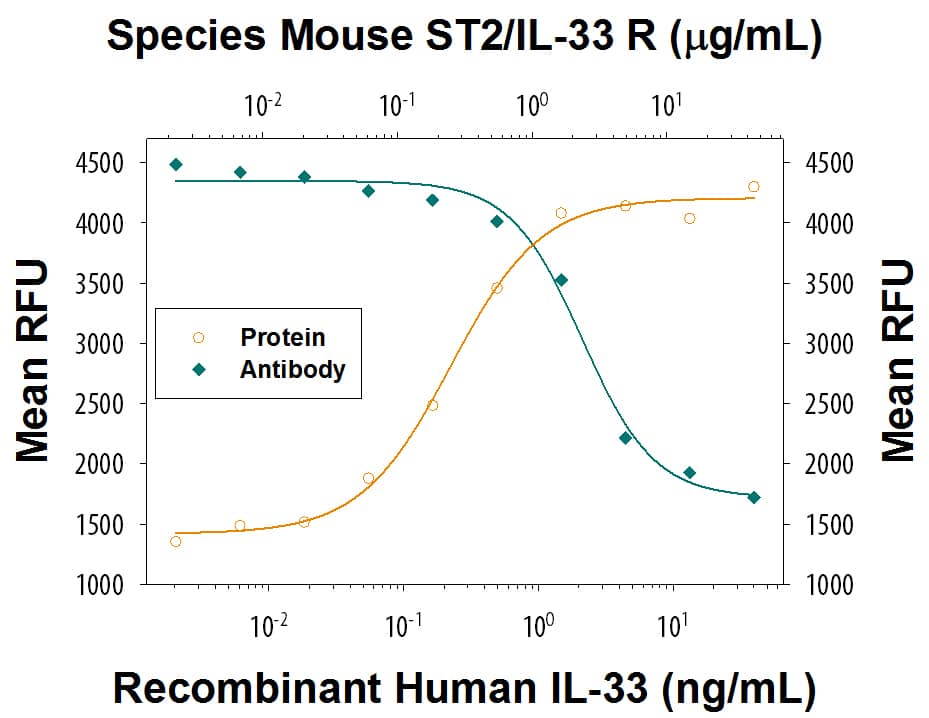Mouse ST2/IL-33R Antibody
R&D Systems, part of Bio-Techne | Catalog # AF1004


Key Product Details
Species Reactivity
Validated:
Mouse
Cited:
Mouse
Applications
Validated:
Neutralization, Western Blot
Cited:
Immunohistochemistry-Frozen, In vivo assay, Neutralization, Western Blot
Label
Unconjugated
Antibody Source
Polyclonal Goat IgG
Product Specifications
Immunogen
S. frugiperda insect ovarian cell line Sf 21-derived recombinant mouse ST2/IL-33 R
Ser27-Arg332
Accession # P14719
Ser27-Arg332
Accession # P14719
Specificity
Detects mouse ST2/IL-33 R in direct ELISAs and Western blots. In direct ELISAs, approximately 10% cross-reactivity with recombinant human ST2/IL-33 R is observed.
Clonality
Polyclonal
Host
Goat
Isotype
IgG
Endotoxin Level
<0.10 EU per 1 μg of the antibody by the LAL method.
Scientific Data Images for Mouse ST2/IL-33R Antibody
Cell Proliferation Induced by IL‑33 and Neutralization by Mouse ST2/IL-33 R Antibody.
Recombinant Human IL-33 (Catalog # 3625-IL) induces proliferation in the D10.G4.1 mouse helper T cell line in a dose-dependent manner (orange line), as measured by Resazurin (Catalog # AR002). Under these conditions, proliferation elicited by IL-33 is neutralized (green line) by increasing concentrations of Goat Anti-Mouse ST2/IL-33 R Antigen Affinity-purified Polyclonal Antibody (Catalog # AF1004). The ND50 is typically 1-6 µg/mL.Applications for Mouse ST2/IL-33R Antibody
Application
Recommended Usage
Western Blot
0.1 µg/mL
Sample: Recombinant Mouse ST2/IL-33 R Fc Chimera (Catalog # 1004-MR)
Sample: Recombinant Mouse ST2/IL-33 R Fc Chimera (Catalog # 1004-MR)
Neutralization
Measured by its ability to neutralize IL‑33-induced proliferation in the D10.G4.1 mouse helper T cell line. Schmitz, J. et al. (2005) Immunity 23:479. The Neutralization Dose (ND50) is typically 1-6 μg/mL in the presence of 1 ng/mL Recombinant Human IL‑33.
Reviewed Applications
Read 1 review rated 4 using AF1004 in the following applications:
Formulation, Preparation, and Storage
Purification
Antigen Affinity-purified
Reconstitution
Reconstitute at 0.2 mg/mL in sterile PBS. For liquid material, refer to CoA for concentration.
Formulation
Lyophilized from a 0.2 μm filtered solution in PBS with Trehalose. *Small pack size (SP) is supplied either lyophilized or as a 0.2 µm filtered solution in PBS.
Shipping
Lyophilized product is shipped at ambient temperature. Liquid small pack size (-SP) is shipped with polar packs. Upon receipt, store immediately at the temperature recommended below.
Stability & Storage
Use a manual defrost freezer and avoid repeated freeze-thaw cycles.
- 12 months from date of receipt, -20 to -70 °C as supplied.
- 1 month, 2 to 8 °C under sterile conditions after reconstitution.
- 6 months, -20 to -70 °C under sterile conditions after reconstitution.
Background: ST2/IL-33R
References
- Barksby, H.E. et al. (2007) Clin. Exp. Immunol. 149:217.
- Gadina, M. and C.A. Jefferies (2007) Science STKE 2007:pe31.
- Yanagisawa, K. et al. (1993) FEBS Lett. 318:83.
- Schmitz, J. et al. (2005) Immunity 23:479.
- Lecart, S. et al. (2002) Eur. J. Immunol. 32:2979.
- Brint, E.K. et al. (2004) Nat. Immunol. 5:373.
- Weinberg, E.O. et al. (2002) Circulation 106:2961.
- Sanada S. et al. (2007) J. Clin. Invest. 117:1538
- Palmer, G. et al. (2008) Cytokine 42:358.
- Chackerian, A.A. et al. (2007) J. Immunol. 179:2551.
- Allakhverdi, Z. et al. (2007) J. Immunol. 179:2051.
- Verri Jr., W.A. et al. (2008) Proc. Natl. Acad. Sci. 105:2723.
- Miller, A.M. et al. (2008) J. Exp. Med. 205:339.
- Hayakawa, H. et al. (2007) J. Biol. Chem. 282:26369.
Long Name
Interleukin 33 Receptor
Alternate Names
DER4, Fit-1, IL-1 R4, IL-1R4, IL-1RL1, IL-33 R, IL-33R, IL1R4, IL33R, Ly84, ST2L, ST2V, T1
Gene Symbol
IL1RL1
UniProt
Additional ST2/IL-33R Products
Product Documents for Mouse ST2/IL-33R Antibody
Product Specific Notices for Mouse ST2/IL-33R Antibody
For research use only
